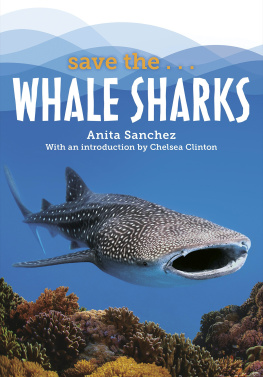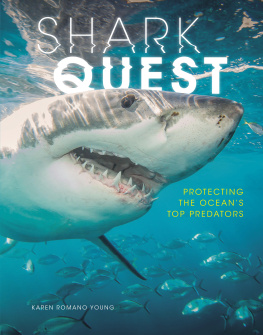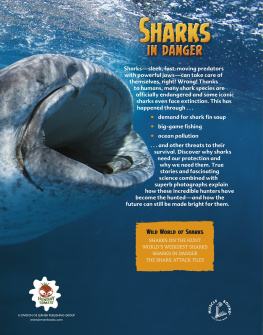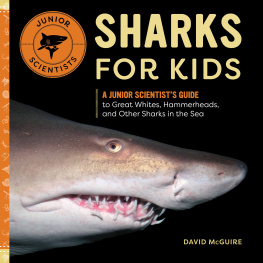Sharks: The Animal Answer Guide
Sharks The Animal Answer Guide
Gene Helfman and George H. Burgess

2014 Johns Hopkins University Press
All rights reserved. Published 2014
Printed in the United States of America on acid-free paper
9 8 7 6 5 4 3 2 1
Johns Hopkins University Press
2715 North Charles Street
Baltimore, Maryland 21218-4363
www.press.jhu.edu
Library of Congress Cataloging-in-Publication Data
Helfman, Gene S.
Sharks : the animal answer guide / Gene Helfman and George H. Burgess.
pages cm
Includes bibliographical references and index.
ISBN 978-1-4214-1308-2 (hardcover : alk. paper) ISBN 978-1-4214-1309-9 (pbk. : alk. paper) ISBN 978-1-4214-1310-5 (electronic) ISBN 1-4214-1308-6 (hardcover : alk. paper) ISBN 1-4214-1309-4 (pbk. : alk. paper) ISBN 1-4214-1310-8 (electronic) 1. ChondrichthyesMiscellanea. 2. SharksMiscellanea. I. Burgess, George H., 1949 II. Title.
QL638.6.H45 2014
597.3dc23 2013027724
A catalog record for this book is available from the British Library.
Special discounts are available for bulk purchases of this book. For more information, please contact Special Sales at 410-516-6936 or .
Johns Hopkins University Press uses environmentally friendly book materials, including recycled text paper that is composed of at least 30 percent post-consumer waste, whenever possible.
Contents
Acknowledgments
Knowledge about sharks and their relatives grows daily. Long before this information appears in the scientific literature, it is generously shared with other shark lovers and researchers. Many of the facts and ideas presented here fall into this category of new, verified information that has not yet quite become publicly accessible. In addition, much information about sharks appears regularly on websites, without reliably identifiable sources. Our colleagues around the world have aided us in finding the former and verifying the latter, for which we are exceedingly grateful.
For permission to use illustrations and for providing or verifying information on various subjects we thank a host of people, including Aaron Fisk, Adam Summers, Austin Gallagher, Bruce Carlson, Bruce Masse, Cam Macdonald, Carolyn Moser, Colin Simpfendorfer, Dave Ebert, Dave Hally, Dave Harasti, Dave Sumang, Dayv Lowry, David Sims, Dovi Kacev, Duncan Elkins, Ellis Loew, Greg Cailliet, Harry Fierstine, Jack Randall, Jane Watson, J. B. Heiser, Jean Spalti, Jeff Rotman, Jenny Kemper, Jim Whittington, Jimmy Bernot, Joe Gaydos, Johann Mourier, John Ford, John McCosker, Jose Castro, Judy Meyer (!!), Kara Yopak, Kaye DeHays, Ken Goldman, Kyle Mara, Laura Kozuch, Maria Pickering, Marj Awai, Mark Hixon, Matthew McDavitt, Michal Heithaus, Misty Paig-Tran, Mo Donnelly, Nick Dulvy, Olaf Weyl, Paul Skelton, Paul Vecsei, Phil Motta (!), Phillip Weemstra, Ralph Collier, Randall Dahn, Randy Honebrink, Ryan Kempster, Samantha Mulvany, Sonny Gruber, the South African Institute of Aquatic Biology (SAIAB), the Whale Interpretive Centre, Tim Berra, Tim Higham, Tom Emerson, Tom Reinert (!), Wes Pratt, and Zeb Hogan.
Our special thanks to Vincent Burke, Jennifer Malat, and Sara Cleary of Johns Hopkins University Press for their patience with and understanding of our halting progress in compiling this book. They proved that the publishing industry is far from the heartless monolith that authors often claim it to be.
And in particular we thank our wives, Judy Meyer and Linda Schulze Burgess, for their encouragement, patience, and crucial support, without which this book could never have been completed.
One historical note. Books about sharks abound. Many aim at an elementary level and a fairly young audience, are filled with photographs or drawings, sensationalize or overemphasize the spectacular or speculative, and provide little technical detail for someone interested in more than basics. At the other extreme are the scholarly textbooks and volumes written by experts, targeted at a college or professional audience, providing great detail or the latest research findings for persons who already possess an extensive biological education. Comparatively few are written for people with little prior knowledge of sharks, but with a curiosity and interest in finding out more about them (Springer and Gold 1989, p. 10). Our intended readers are the same for which Springer and Gold wrote Sharks in Question, namely, intelligent people who want more than the basics without the hype and arent afraid of the technical detail necessary to fully appreciate why sharks are worthy of study. Springer and Gold accomplished this superbly, and we hope to reach the same audience and level of detail, updating the material in that now out-of-print volume.
Springer and Gold concluded their influential 1989 volume by observing, You can be certain that many more books about sharks will be written as new information increases our understanding; quite possibly, the future authors are among our readers (p. 145). They were correct on both counts. We are grateful for their inspiration and hope that we too will stimulate future efforts at understanding, explaining, and promoting the natural history, biology, behavior, and conservation of these fascinating animals.
Introduction
From Gene Helfman
George Burgess and I both became fascinated with sharks at an early age. My shark career began when I was maybe 9 or 10. Someone landed a Basking Shark at the Santa Monica Pier in southern California. The Los Angeles Times ran an article with a photo, including an interview with a biologist from the California Department of Fish and Game, Dr. John Fitch. At my fathers encouragement, I wrote Dr. Fitch a letter that Im sure I would find embarrassing today; I probably asked some basic questions and said what a neat animal the shark was. To my astonishment, he wrote back. Thats really all it took. I was hooked. Someone important thought my interest was worthwhile.
I read just about every shark book available in English before I was 12. All my reports, for science or other classes, were about sharks. When I entered Van Nuys High School, I hooked up with a couple of other shark nuts, and we formed a group we called the Shark Research Committee. (The Shark Research Committee still exists, still chaired by Ralph Collier, who has since written a book on shark attacks along the Pacific coast.) Encouraged by a biology teacher, we contacted Dr. Marshall Urist at UCLA, a researcher interested in shark blood chemistry. We happily spent all-nighters catching Spiny Dogfish from fishing barges off Redondo Beach for Dr. Urist. We were collecting sharks for science! We were on top of the world.
I entered college at UCLA, intent on a career that would lead to developing an effective shark repellant. That intent evaporated when I realized I was not a gifted chemist, or at least not a very good chemistry student. I completed my undergraduate studies, as a zoology not a chemistry major, at UC Berkeley, where I got more serious about sharks and fishes in general. I learned to scuba dive and managed the zoology departments fish collection. I took ichthyology (fish biology) from the late Dr. George Barlow, an animal behaviorist, which got me started observing fish behavior. Upon graduating, I joined the Peace Corps in Palau, Western Caroline Islands, as a fisheries specialist. Palau has spectacular coral reefs, and I spent most work hours and every weekend diving, catching, and watching fishes. I had my first up-close-and-personal encounters with a variety of reef sharks, often in the form of keeping them from stealing fish I had speared. I also was fortunate enough to serve as a local guide and field assistant to Dr. John (Jack) Randall of the Bishop Museum in Hawaii, a world expert on coral reef fishes. Jack and I published two papers on fishes in Palau, one on local fish names and a second on the biology of and attacks by Blacktip Reef Sharks in the journal
Next page









